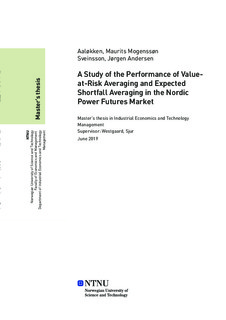| dc.contributor.advisor | Westgaard, Sjur | |
| dc.contributor.author | Aaløkken, Maurits Mogenssøn | |
| dc.contributor.author | Sveinsson, Jørgen Andersen | |
| dc.date.accessioned | 2019-08-24T14:03:04Z | |
| dc.date.available | 2019-08-24T14:03:04Z | |
| dc.date.issued | 2019 | |
| dc.identifier.uri | http://hdl.handle.net/11250/2610702 | |
| dc.description.abstract | I denne oppgaven undersøker vi hvordan kjente univariate risikomodeller brukt til Value-at-Risk(VaR) og Expected Shortfall(ES) presterer i det meget volatile markedet for fremtidskontrakter på strøm, for deretter å undersøke hvorvidt gjennomsnitt av forskjellige konstellasjoner av de samme modellene gir bedre resultater enn de individuelle modellene.
Modellene vi bruker for å kalkulere Value-at-Risk er normally-distributed GARCH, t-distributed GARCH, normally-distributed GJR-GARCH, t-distributed GJR-GARCH, quantile regression ved bruk av normally-distributed GARCH, quantile regression ved bruk av t-distributed GARCH, quantile regression ved bruk av normally-distributed GJR-GARCH, quantile regression ved bruk av t-distributed GJR-GARCH, quantile regression ved bruk av RiskMetrics, RiskMetrics med Cornish Fisher og Filtered Historical Simulation ved bruk av t-distributed GARCH. Vi bruker normally-distributed GARCH, t-distributed GARCH, RiskMetrics med Cornish Fisher og Filtered Historical Simulation ved bruk av t-distributed GARCH for å kalkulere Expected Shortfall.
For å teste hvorvidt et gjennomsnitt av de utvalgte modellene gir bedre resultater enn det de samme modellene klarer på egenhånd, bruker vi Kupiecs Unconditional Coverage test og Christoffersens Conditional Independence test, mens prestasjonen til modellene brukt til å beregne Expected Shortfall, blir målt ved bruk av McNeil og Freys fremgangsmåte.
Resultatene våre viser at gjennomsnittsmodellene presterer veldig solid for Value-at-Risk, både for in-sample fit og for out-of-sample testing. Den generelle tendensen blant de individuelle modellene, er at modellene som inkluderer kvantilregresjon presterer best. T-distributed GARCH presterer bedre enn normally-distributed GARCH på grunn av de tykke halene i det nordiske markedet for fremtidskontrakter på strøm. Filtered Historical Simulation presterer greit, mens Cornish Fisher approksimasjonen til RiskMetrics ikke evner å ta riktig høyde for de tykke halene i det nordiske markedet for fremtidskontrakter på strøm. Gjennomsnittsmodellene presterer like godt som de beste individuelle modellene.
For Expected Shortfall in-sample fit og out-of-sample backtesting, er konklusjonen klar; gjennomsnittsmodellene som inkluderer Filtered Historical Simulation, t-distributed GARCH og normally-distributed GARCH presterer veldig bra. Blant de individuelle modellene, er t-distributed GARCH den eneste modellen som prester akseptabelt. RiskMetrics med Cornish Fisher og normally-distributed GARCH undervurderer risikoen i stor grad, mens Filtered Historical Simulation overvurderer risikoen i stor grad. Gjennomsnittsmodellene presterer like godt eller bedre enn den beste individuelle modellen. | |
| dc.description.abstract | The purpose of this study is to investigate the performance of well known univariate risk models for both Value-at-Risk and Expected Shortfall in the highly volatile Nordic power futures market, and study whether simple averages of the same models used to calculate Value-at-Risk(VaR) and Expected Shortfall(ES) provide better results than the individual models.
The individual models used for calculating Value-at-Risk are normally-distributed GARCH, t-distributed GARCH, normally-distributed GJR-GARCH, t-distributed GJR-GARCH, quantile regression using normally-distributed GARCH, quantile regression using t-distributed GARCH, quantile regression using normally-distributed GJR-GARCH, quantile regression using t-distributed GJR-GARCH, quantile regression using RiskMetrics, RiskMetrics with Cornish Fisher and Filtered Historical Simulation using t-distributed GARCH. We use normally-distributed GARCH, t-distributed GARCH, RiskMetrics with Cornish Fisher and Filtered Historical Simulation using t-distributed GARCH to calculate Expected Shortfall.
The performance of the models used to predict Value-at-Risk is assessed using the Unconditional Coverage test of Kupiec and the Conditional Independence test of Christoffersen. The performance of the models used to predict Expected Shortfall is assessed using the backtesting procedure described by McNeil and Frey.
The results show that the simple average models chosen perform very well for Value-at-Risk, both in- and out-of-sample. The general tendency when backtesting VaR both in- and out-of-sample, is that the models including the quantile regression approach perform best among the individual models. T-distributed GARCH outperforms normally-distributed GARCH due to the fat tails of the Nordic power futures. Filtered Historical Simulation performs acceptable, while RiskMetrics with Cornish Fisher approximation is not able to correctly account for the fat tails. The simple average models perform just as good as the best individual models.
For the ES in-sample fit and out-of-sample backtesting, the conclusion is quite clear cut; the simple average models that includes Filtered Historical Simulation, GARCH with t-distribution and GARCH with normal-distribution perform very well. Among the individual models, GARCH with t-distribution is the only model performing acceptable. RiskMetrics with Cornish Fisher and GARCH-n tend to strongly underestimate the risk, while Filtered Historical Simulation tends to strongly overestimate the risk. The simple average models perform equally good or better than the best individual model. | |
| dc.language | eng | |
| dc.publisher | NTNU | |
| dc.title | A Study of the Performance of Value-at-Risk Averaging and Expected Shortfall Averaging in the Nordic Power Futures Market | |
| dc.type | Master thesis | |
